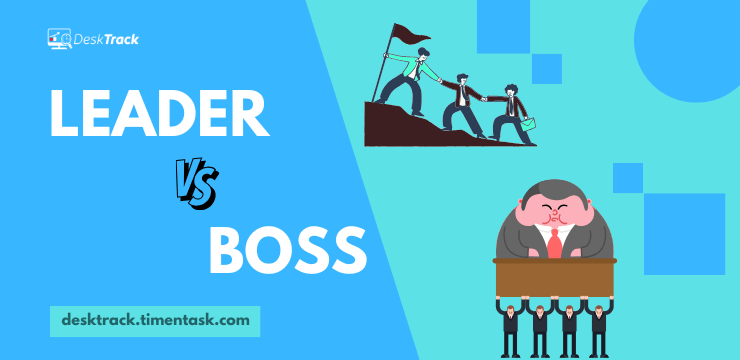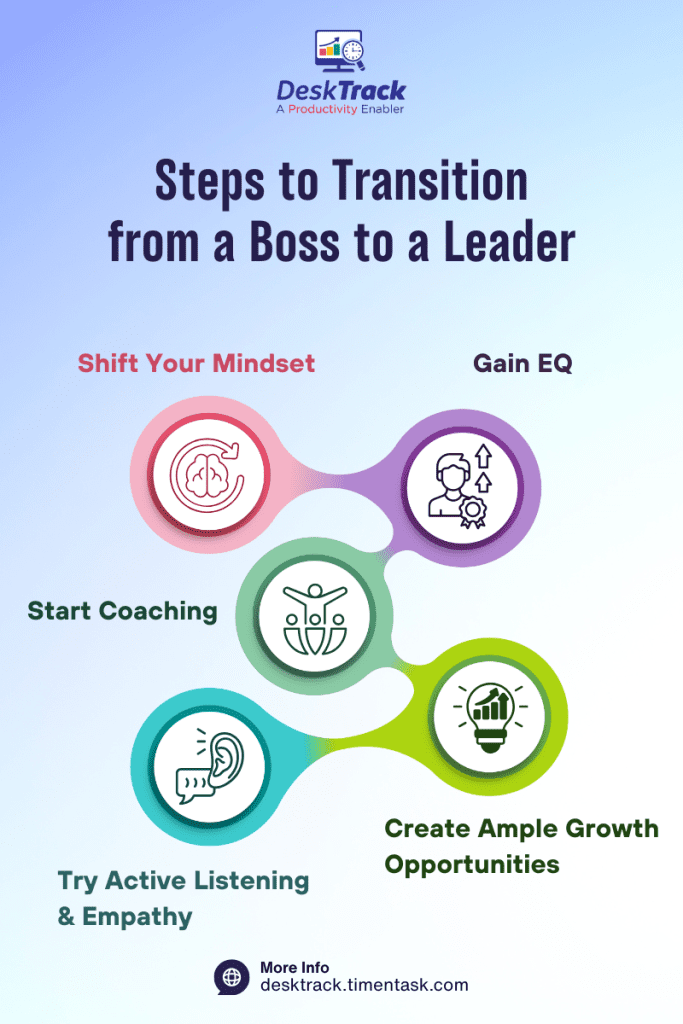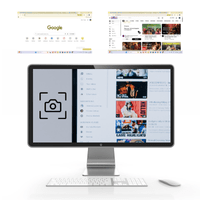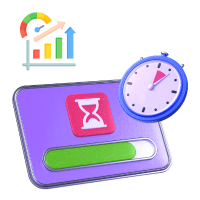
Leader vs. boss. Why are we still discussing this matter? That’s because we need leaders and not bosses. However, how can we differentiate between these two birds of a feather?
Besides, when there is leadership in your organization and not bossship, you can see a 50% increase in employee retention rate and a 20% increase in productivity. However, if there are people of higher authority bossing around everyone, there will be a marginal decline in these and other stats, such as employee engagement.
That’s why we are here to help you know the differences and even transition to a good leader in this boss vs. leader blog. So, with that out of our way, let’s get started.
Who is a Boss?
A boss is an owner who either owns his employees or has an impression that they do. Bosses believe in accountability and employee engagement via authority. Although they do invest in short-term goals and tasks, they don’t invest in people and consider themselves a separate entity from those who are working below them.
Who is a Leader?
On the other hand, a leader has an opposite mindset and personality from a boss. For starters, they consider themselves a part of the group they are coaching and leading by example. A leader is a team member and takes total accountability for their mistakes, while a boss will shift the blame for sure. Plus, a leader invests in people and believes in boosting accountability and engagement via communication and understanding.
Read Also: Top 15 Business Expense Tracking Apps in 2025
Boss Vs. Leader: The 10 Key Differences Between the Two

The difference between a leader and a boss is significant. Although at the end of the day, both of them have to get the results, the main difference lies in how they get human resources to follow the orders:
1. Authority Vs. Influence
| Boss | Leader |
| Bosses impose rules and authority. They expect employees to follow the rules in a no-questions-asked fashion to get the work done. | Leaders also follow the rules they make, positively influencing the employees they are working with. There is some level of authority. However, with a flexible working policy. |
2. Command Vs. Collaboration
| Boss | Leader |
| Bosses give commands and orders, which employees and teams follow. They dare not ask any doubts directly to the boss. | A leader works with his people to push through to success no matter what. She or he inspires their employees to work better and better |
3. Control Vs. Empowerment
| Boss | Leader |
| Bosses always control. One of the leader vs. boss examples is that they make all the decisions, decide all the processes, etc. | A leader empowers their employees to make decisions. Although the final decision is still in the leader’s hands, there is no control. |
4. Micromanagement Vs. Trust
| Boss | Leader |
| Bosses micromanage out of the expectation for perfection. However, they may not even care if their employees are experiencing burnout due to them asking to put the boss’s emails in every CC, asking for updates every hour, and jumping behind the employees’ desks unexpectedly. | Leaders trust their employees. However, not blindly. They still use the best screenshot monitoring software to prevent insider threats and streamline workflows. All-in-all, there is no micromanagement involved here. |
5. Short-Term Vs. Long-Term Vision
| Boss | Leader |
| Speaking of the leader vs. boss mentality, the latter is always focused on completing short-term goals, believing they lead to the achievement of the long-term objectives together, one step at a time. This may work. However, bosses always miss the big picture along the way. | A leader always focuses on the long-term vision, strategizing, delegating, and preparing with their teams accordingly. This mentality works and achieves success 100% of the time. Plus, it’s flexible and adaptable to unexpected changes as well. |
6. Blame Vs. Accountability
| Boss | Leader |
| This one is a classic. Everyone knows that bosses are greedy people. So, they will always take the credit for all the good work for themselves. However, even when the mistake is their own fault, they will shift the blame to the other team members to stay in the safe zone. | On the other hand, a leader will always take accountability for their mistakes, inspiring their teams to be accountable and responsible. Plus, a leader may even take a stand to clear any misunderstandings, or if the team member at fault was having a bad day. |
7. Compliance Vs. Engagement
| Boss | Leader |
| As we mentioned before, bosses set rules and authority. Employees must comply with these rules. | A leader inspires their employees and increases engagement by celebrating milestones and even small achievements. |
8. Fear Vs. Inspiration
| Boss | Leader |
| Wherever there are strict rules and authority, there will always be fear. Bosses are no exceptions to this fact. Employees work like robots out of fear of being discontinued for any reason at any time. There is no creativity and inspiration. | Leaders lead by example and motivate their teams to keep working better and better. They might even present employees with surprise treats such as muffins or pizzas that make the breaks even more delightful and strengthen professional bonds. |
9. Rigid Vs. Adaptive
| Boss | Leader |
| Once a boss has made a decision, they will stick to it, even if it is failing miserably. We all know that when it fails, they will blame the employees for it. | On the other hand, leaders tell. However, they also listen to their employees. Plus, they have no issue adapting to unexpected changes and coaching their teams to easily adjust for the better. |
10. Task-Focused Vs. People-Focused
| Boss | Leader |
| Bosses are only task-focused. The work must get done. On the other hand, employee well-being is not even in their dictionary. | Leaders blend task-focus and people-focus into the perfect mix. They believe that when their employees are physically and mentally fit, they will be able to work to the best of their skills. So, they invest in wellness programs for professionals from time to time. |
Why the Next Generation Workforce Expects Leaders
Make your workday more productive
Time tracking and work management can help you reach your goals
faster.
So, now we know the difference between a boss and a leader. These distinctions have also given away why millennials and Gen Z human resources need leaders. Still, let us make it clearer. True leaders are:
- Authentic and they accept their vulnerabilities, the new workforce acknowledges this quality as perfect, as they have seen fake commitments and are all aware of false promises.
- Have a purpose and help employees realize it. The new generation wants to connect to a purpose, and so they must work under leaders.
- The new generation workforce wants to be trusted and work in a flexible environment. We all know that only true leaders can provide that.
- Gen Z workers in particular want to experience mentorship. They want growth opportunities and won’t wait years to get a promotion. So they need to work under leadership.
- Most importantly, Gen Z employees need leaders who take action.
Read Also: How Many Work Hours in a Year: A Complete Guide
Steps to Transition from a Boss to a Leader

If you are still reading this, it means that you have realized that you are a boss. Probably a terrible one. So, if you still have some self-respect, we request that you implement these steps to transition to a good leader.
1. Shift Your Mindset
The first step is always the hardest. Since you have been making people work with an implementation of rules and authority, switching to collaboration and flexibility will be a challenge. However, this is a must-have to be a good leader.
2. Gain EQ
To be the former in the leader vs. boss competition, you also need to gain emotional intelligence or emotional quotient. Yes, indeed, you don’t want to mix your personal and professional life. However, being emotionally invested in your employees helps you better understand how they work best. Plus, it also strengthens:
- Trust
- Teamwork
- Comprehension
3. Try Active Listening & Empathy
A leader listens proactively to their employees. This includes their concerns, issues, and problems with the work culture and workplace. If your best employees start showing a decline in performance all of a sudden, you need to get to the root of the problem with 2-way communication.
4. Delegate & Trust
Once you have delegated a task or tasks, you have nothing to do with it, except for guiding your teams to complete the task. However, you can’t trust your workers blindly. Use the best employee monitoring software to track activities and improve efficiency.
5. Start Coaching
Again, start coaching and stop imposing too much authority. Remember that you weren’t born perfect either, but were grown to. So, you must be willing to do the same to your employees. This also makes you more likable, trustworthy, and increases engagement at work.
6. Create Ample Growth Opportunities
Creating growth opportunities for your employees increases productivity by around 50%. As a bonus, it also increases employee retention rate, which saves you the expense of hiring new candidates for the same posts every month. Especially if you are dealing with Gen Z and millennials in your teams.
Transition from a Boss to a Leader with DeskTrack
This wraps up the leader vs. boss debate. As a final word, if you want to become a leader, DeskTrack’s time tracking software can help. It is scalable and adaptable to any leadership style and workflow. Not only that, it helps you assist where you are lagging with real-time insights and reports that will help you in your journey to transition from a boss to a great leader, streamlining the process. Once you are a leader, continue using DeskTrack to prevent insider threats, streamline workflows, manage projects, track time, analyze data, and maximize staff productivity.
Frequently Asked Questions (FAQ)
Q. Who is a Boss?
Ans. A boss is an owner who either owns his employees or has an impression that they do. Bosses believe in accountability and employee engagement via authority. Although they do invest in short-term goals and tasks, they don’t invest in people and consider themselves a separate entity from those who are working below them.
Q. Who is a Leader?
Ans. On the other hand, a leader has an opposite mindset and personality from a boss. For starters, they consider themselves a part of the group they are coaching and leading by example. A leader is a team member and takes total accountability for their mistakes, while a boss will shift the blame for sure. Plus, a leader invests in people and believes in boosting accountability and engagement via communication and understanding.
Q. Is a Leader Higher than a Boss?
Ans. Bosses are above the team. Leaders are a part of the team. However, that’s only the hierarchy. From a tramplayer perspective, leaders are much better than bosses.
Q. What is the Difference between a Leader & a Boss?
Ans. A boss commands, authorizes, controls, and rules. However, a leader inspires, takes action, prioritizes HR, motivates, and collaborates to achieve success together.
Q. What are the Qualities of a Leader?
Ans. A true leader has the following qualities.
- Influence
- Collaboration
- Empowerment
- Trust
- Long-Term Vision
- Accountability
- Engagement
- Inspiration
- Adaptive
- People-Focused









